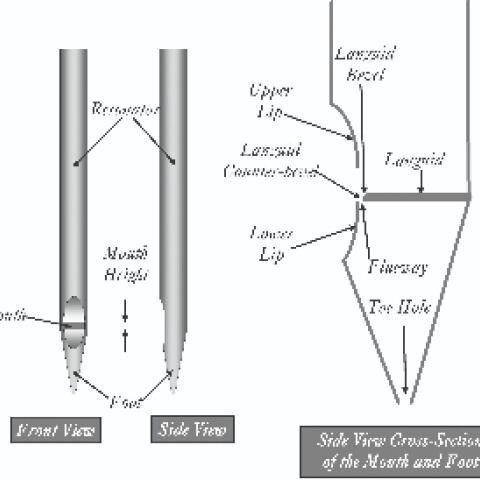Michael McNeil has designed, constructed, voiced, and researched pipe organs since 1973. Stimulating work as a research engineer in magnetic recording paid the bills. He is working on his Opus 5, which explores how an understanding of the human sensitivity to the changes in sound can be used to increase emotional impact. Opus 5 includes double expression, a controllable wind dynamic, chorus phase shifting, and meantone tuning. Stay tuned.

Editor’s note: The Diapason offers here a feature at our digital edition—three sound clips. Any subscriber can access this by logging into our website (thediapason.com), click on Magazine, then this issue, View Digital Edition, scroll to this page, and click on each <soundclip> in the text.
Part 2 of this article is found here.
Deductive logic is tautological; there is no way to get a new truth out if it, and it manipulates false statements as readily as true ones. If you fail to remember this, it can trip you—with perfect logic. . . . Inductive logic is much more difficult—but can produce new truths.1
The late Peter Williams, pipe organ scholar extraordinaire, occasionally remarked to John Brombaugh that he most favored the sound of Gottfried Silbermann. Brombaugh thought this was perhaps a contrarian view, a position Williams often took in their conversations.2 Silbermann’s sound is indeed both deeply admired and controversial.
The sound of an organ is the sum of its scaling, voicing, temperament, windchest design, action, layout, wind system, wind pressure, position in the room, and room acoustics. Among these factors, only the art of voicing is perceived as the elite province of a select and gifted few, shrouded in mystery. But as Reiner Janke has so ably demonstrated, voicing can be understood by anyone willing to commit the effort.3
Pipe organ literature abounds with subjective opinions of organ sound and the received wisdom of voicing recipes. These often contain a kernel of truth, but they can sometimes lead us down perilous paths. We will use data and inductive logic to give us insight into Silbermann’s voicing. And in Part 2 of this article we will use those insights to gain a wider perspective on voicing in general by comparing Silbermann’s voicing with a wide range of other styles. In the process we will see what makes Gottfried Silbermann’s sound so interesting.
Fundamentals of scaling and voicing
A quick overview of the features of organ pipes, scaling, and voicing may help readers unfamiliar with these terms. Figure 1 shows the basic features of an organ pipe and the terms used in this article.
Scaling and wind pressure determine the maximum power of a pipe. Scaling includes the diameter of a pipe’s resonator and the width of its mouth. Wider resonators and wider mouths will produce more power, as will higher wind pressure. Scaling also affects the vowel sound, or timbre, of a pipe, ranging from the “ah” of wider scales to the “ee” of narrower scales. The “ah” consists of the fundamental that increases in power in wider resonators. Narrower resonators will emphasize the power of higher harmonics with a brighter timbre.
In Figure 1 we see that the flueway of a pipe is the slit formed by the lower lip and the languid, the horizontal plate soldered on top of the pipe’s foot. The wind from the chest enters through the toe hole into the pipe’s foot and exits through the flueway slit. The languid’s edge turns the sheet of wind formed by the flueway into a spinning vortex. The upper lip cuts the vortex, creating pulsations of pressure that will drive the resonator to sound if the conditions are right.
The vortex spins fastest at the languid edge and spins slower as it expands towards the upper lip. If the height, or “cutup,” of the mouth’s upper lip cuts the vortex where it pulsates at the same frequency that the resonator is tuned, the pipe will speak very quickly.4 Lower cutups create higher frequency pulsations where the vortex spins faster. The resonator has more difficulty with faster pulsations, and the speech is both slower to form and brighter with more powerful harmonics. Keep lowering the cutup, and at some point the resonator cannot “resonate” with the vortex at the fundamental, and an open pipe will overblow to the octave, its second harmonic. More pressure or more wind from a larger toe will make the vortex spin faster with more energy, and the cutup will have to rise.
Voicing begins by adjusting the flueway depth and/or the diameter of the toe to control the power (this is also known as “regulation”). More wind from larger toes and deeper flueways produces more power.
A voicer will raise the height of the cutup by degrees to adjust the timbre, making the sound continuously less bright and more like a flute as cutup is increased. Cutup is by far the most sensitive aspect of voicing—very small changes in cutup will make big changes in timbre. While toe areas, flueway areas, and wind pressure have proportional effects on a pipe’s power, its cutup has an exponential effect on its timbre; Ising showed that it is a cube function!
When we say that an organ is voiced in a Germanic or French style, what does this mean? Received wisdom relates that Germanic voicing leaves the toe wide open and closes the flueway to regulate power, while French voicing emphasizes a deeply open flueway and closes the toe to regulate power. Does this make a difference? Charles Fisk thought it made a great difference, and he wrote with passion about the musicality of deeper flueways in 1975.5 Subjective impressions suggest that deeper flueways result in a warmer fundamental with less percussive speech when power is regulated with closed toes. Physics tells us that the pressure in the foot and the velocity of air in the flueway will be lower as the toe area decreases and the flueway area increases, and the vortex will spin more slowly.
The musical range of flueway depths spans the very deep flueways of romantic voicing to the more closed flueways exemplified by the work of organ builders like D. A. Flentrop. The received wisdom of Germanic voicing often assumes the sole use of closed flueways to regulate power, but the reality is more complex. How do we know this?
The minimum required data
Typical organ documentation lists pipe diameters, mouth widths, and cutups, but ignores the crucial voicing data of flueway depths and toe diameters, and this unfortunately tells us little about the sound. For example, without the toe and flueway data we do not know if the cutup data imply a softer and smoother sound with more closed toes and flueways or a powerful, brighter sound with more open toes and flueways. As Ising has shown, cutups and the timbre they control are extremely sensitive to changes in pressure and the flow of wind in toes and flueways.
While voicing data of most organbuilders, including Arp Schnitger, are exceedingly rare, our knowledge of Gottfried Silbermann is made possible by the work of Frank-Harald Greß and his documentation of voicing for several of Silbermann’s organs.6, 7, 8 To make matters far worse in our quest to understand historic voicing, many organs have been revoiced, repitched, retuned in new temperaments, and their wind pressures raised or lowered during their restorations, often on multiple occasions. We will have great difficulty discovering the original sound of most older organs. We owe a great debt to F.-H. Greß, who has documented the changes made to each of Silbermann’s surviving organs.
Early influences
Gottfried Silbermann was born in 1683 in Kleinbobritzsch, Saxony, the son of a carpenter. His older brother, Andreas, “left home in great haste to avoid military conscription” and worked for Eugenio Casparini on the Görlitz organ before settling in Strasbourg, Alsace, as an independent organbuilder.9 Andreas spent the years 1704–1706 learning French organbuilding from François Thierry in Paris. Andreas was at first rebuffed in Paris, but found a willing mentor in Thierry, who would later build the organ we now see in Notre Dame de Paris. Little is known of Gottfried’s youth, but we know that he joined Andreas in Strasbourg in 1702, earned his title as a master organbuilder, and returned to Saxony with two journeymen and an apprentice. He built his first organ in Frauenstein in 1709 and 1710 and spent the rest of his life building nearly all of his organs in Saxony. Gottfried died late one night in August of 1753 while voicing the organ in the Dresden Hofkirche.10
Gottfried “was accustomed to throw his cane on the floor when he wanted to judge the acoustics in a church.”11 This shrewd test creates a broad range of frequencies which will decay at different rates, informing Silbermann of the room’s different absorption of sound from bass to treble. This is very similar to what acousticians do today with a blank gunshot. He notoriously refused to build organs in churches whose acoustics were poor, and he would likely be appalled at the acoustics of most American churches.12
Scaling
Gottfried Silbermann’s scaling, voicing, and stoplists were extremely consistent. He had three sets of principal chorus scales, wider to narrower, which he used to differentiate the timbre of his different divisions. He also used one of the narrower scales for his mixtures.13 More wind pressure was employed to fill larger or less efficient acoustics. Unlike most other organbuilders, he never found the need to experiment with different sounds.
Silbermann’s layouts were well engineered and featured easy access, which probably has much to do with the longevity of his organs. He has been criticized for the regularity of his tonal schemes, but this regularity helps us understand how he achieved that sound by comparing his least modified surviving organs. Silbermann became relatively wealthy as an organbuilder, an impossible achievement for modern organbuilders who design their classically inspired organs as completely unique creations.
We will use graphs presented in Normal Scales to understand Silbermann’s sound. Tables of raw numbers do not convey the underlying intent of the organbuilder, and Normal Scales allow us to make easy visual comparisons. These Normal Scales were published in the author’s article, “1863 E. & G. G. Hook Opus 322: Church of the Immaculate Conception, Boston, Massachusetts, Part 1,” The Diapason, July 2017, page 18. Those who want actual measurements can use those tables to convert the Normal Scale data in this article into raw data.14
Diameter scales of the 1714 Freiberg Dom Hauptwerk principal chorus are shown in Figure 4. The mid-range scales are narrower, emphasizing less power and more harmonic brightness. In Figure 5 we see the mouth widths. Normal Scale mouth widths are based on mouths which are ¼ of the pipe circumference. Silbermann’s mouths are wider, a very unusual practice. The figure captions describe Silbermann’s scaling in more detail.
Influence of French voicing
The roots of Gottfried Silbermann’s sound lie in French voicing, and an essential feature of classical French voicing is a deeply open flueway. Figure 2 shows an image taken by Reiner Janke of Andreas Silbermann’s voicing. We are looking down into the mouth of a tenor G pipe from the Hauptwerk 4′ Prestant in the 1709 organ at Marmoutier. Note the deep 0.7 mm flueway, the absence of ears, and the alternating deeper and shallower nicks on the languid edge. To put this flueway into perspective, Figure 3 shows an image of a modern, “neo-Baroque” pipe of a similar pitch with a low cutup, a flueway of 0.27 mm depth, and ears. The flueway in Figure 3 is the thin black line.
Divergence from French influence
Gottfried Silbermann designed his organs for exceptional power, even by modern standards. While the sound of Gottfried Silbermann is based on the deep flueways of French voicing, it differs from French voicing in specific ways to get that power.
French flueways tend to be very deep, pushing the maximum limits of musicality, and this might lead us to think that these pipes are very powerful. But classical French voicing uses more closed pipe toes to limit the wind for a more restrained power. We will see in Part 2 that Gottfried’s toes are more open than typical French voicing, and they feed wider mouths.
Mouth widths range from about 2⁄7 to 1⁄7 of the circumference of a pipe. Wider mouths on the same resonator will have more wind flow and proportionally more power. Very small mouths will have a delicate effect. Classical French scaling does not trend toward the maximum limits in mouth widths, but the scaling of Gottfried Silbermann’s principal chorus does exactly that. The combination of very wide mouths, deep flueways, and more open toes is the source of Silbermann’s power. To get a sense of his wind pressures, Andreas Silbermann’s 1709 organ at Marmoutier is voiced on 69 mm, Gottfried’s organ at the Rötha Georgenkirche is voiced on 76 mm, and Gottfried’s Freiberg Dom organ originally had pressures of 97 mm in the manuals and 109 mm in the pedal.15
Unusual pipe construction
Figure 6 shows the basic features of Gottfried Silbermann’s pipework as recreated by C. B. Fisk, Inc. The bottom image in Figure 6 shows a generous flueway and very fine nicking. The 2⁄7 mouth width is evident here, the maximum practical width. The image at top shows a vertical counterbevel (also called a “counterface”) on the languid and a very high position of the languid; you can see the bottom edge of the languid rising just above the top edge of the lower lip. Such a languid position will move the windsheet outwards, and to compensate for this, Fisk has moved the upper lip outwards by extending the side walls of the pipe. There are no added ears. These are the hallmarks of Gottfried Silbermann’s pipes. The pipe in Figure 2 by Andreas Silbermann shares the deep flueway, counterbevel, and nicking, but it does not have the extended upper lip, high languid, and wider mouth.
The sound
At the 1980 American Institute of Organbuilders convention Charles Fisk demonstrated the voicing of a pipe constructed in the style of Gottfried Silbermann. This pipe produced a sound with very prompt and articulate speech of great power and intensity, which I measured at 90 dB at a distance of one meter.16 The mouth of this pipe is shown in Figure 7.
In voicing this pipe Fisk first set the toe diameter and the flueway depth. He then raised the cutup by degrees and added nicks by degrees to reduce harmonic brightness, while adjusting the languid height for prompt speech. He set the languid high as a consequence of the outward extension of the side walls and upper lip.17 To hear the sound of this pipe, listen to a soundclip of Bach’s Duetto I in E Minor, BWV 802, on Silbermann’s nearly original Principal at the Rötha Georgenkirche. <soundclip 1>
Zacharias Hildebrandt apprenticed to Gottfried Silbermann in 1714. He and Silbermann soon became bitter rivals, but upon Silbermann’s death in 1753, Hildebrandt was given the task of finishing Silbermann’s last organ in the Dresden Hofkirche. The sound of Hildebrandt’s 1746 organ at Naumburg is reminiscent of Silbermann’s deep flueways, but I do not have data to confirm this. Like Silbermann, Hildebrandt used different scales of principals to give his divisions a different character. Here is a soundclip of the Naumburg principals, played in contrast to each other in Bach’s Concerto in D Minor after Vivaldi, BWV 596. <soundclip 2>
The voicing
Voicing data for the Freiberg Dom Hauptwerk are shown in Figure 8, Toe Constants, Figure 9, Flueway Depths, Figure 10, Mouth Heights (cutups), and Figure 11, Ratios of Toe Areas to Flueway Areas. See the figure captions for descriptions of these voicing parameters; their derivations can be found in the author’s book.18 In the simplest terms, toe and flueway areas control power, cutups control timbre, and the ratio of the toe area and flueway area affects speech articulation (also known as “chiff”). The crucial takeaway is that Silbermann’s toes and flueways were extremely regular and not treated as free variables. The free variable for Silbermann was cutup.
The regularity of Silbermann’s voicing is remarkable, and it suggests that he calculated his flueway depths and toe diameters prior to voicing. In Part 2 we will see that this regularity is consistent with other organs voiced on similar wind pressures and built at very different times. The regularity of his tonal designs, scaling, and voicing is evidence that he approached organ design from a set of inductively-derived design rules based on very early experimentation. As we will see in Part 2, the design rules for Silbermann’s toes and flueways were different for lower wind pressures.
Greß’s voicing data encompass several of Silbermann organs in acoustics ranging from smaller and more intimate to spacious and grand.19 Silbermann used higher wind pressure for more power, and at higher pressure a pipe is also brighter. Higher cutups will restore a pipe’s timbre at a higher power.20 In Figure 12 we see mouth heights (cutups) plotted in Normal Scale halftones against pitch. The data in the orange line show the higher cutups of powerful principal pipes voiced on 90 mm pressure at Großhartmannsdorf; the data in the light blue line show the lower cutups of less powerful principal pipes voiced on 70 mm pressure at Reinhardtsgrimma; the timbres are similar.
Gottfried Silbermann used cutups to differentiate the timbre of his flutes and principals at the same pressure. In Figure 13 we see that Silbermann cut his 8′ Bordon pipes at the Freiberg Dom (data in the blue line) far higher than his principals (Figure 12 data in the orange line). This is why a Silbermann Bordon is extremely smooth and his principal has harmonic bite. It is also why they have similar power and can be played against each other. If the flueways had been closed to make the Bordon less bright, it would have had far less power than the principal. Listen to a soundclip at the Rötha Georgenkirche of Bach’s O Mensch, bewein’ dein Sünde Groß, BWV 622, where the Bordon holds its own against the powerful principal. <soundclip 3>
The striking feature of Silbermann’s voicing is that he used only cutup as a free variable during voicing to achieve his sound. The regularity of his toe diameters and flueway depths is virtually unique, and that regularity strongly implies that they were calculated.
In Part 2 we will take a much deeper dive into these voicing parameters and compare Silbermann’s voicing to the work of other organbuilders. Some of the data may challenge conventional assumptions and yield surprising and very useful insights.
To be continued.
Uncredited images reside in the collection of the author. Fr. Thomas Carroll, S.J., graciously suggested clarifications in the prose of this article.
Notes
1. Robert A. Heinlein, The Notebooks of Lazarus Long (New York: G. P. Putnam’s Sons, 1973).
2. John Brombaugh. Personal communication, used by permission via telecommunication of June 2, 2021.
3. Reiner Janke, Copy and Intonation: The tacit knowledge of Reiner Janke, Universität Göttingen, 2018, Youtube video: youtube.com/watch?v=isEWba9rLRY&feature=youtu.be. Figure 2 image is at 9:47. In this video Janke skillfully demonstrates a recreation of the Andreas Silbermann pipe in Figure 2 and its exact voicing. You will not find a better tutorial on voicing. Here are Janke’s instructions to the pipemaker (translated from German), with my notes in brackets [ ]. Pitch: g° Prestant 4′. Wind pressure: 69 mm. Alloy of resonator: 85% tin. Alloy of foot and languid: 10% tin. Inside diameter: 36.5 mm [-2.5 HT]. Mouth width: 29 mm (¼ of circumference) inscribed straight and only lightly pressed [-2.5 HT]. Mouth height (cutup): 8–8.5 mm, upper lip not beveled [arched 0 to +1.5 HT]. Resonator wall thickness: 0.8 mm. Foot wall thickness: 0.9 mm. Foot length: 200 mm. Resonator length: 426 mm. Languid face: 50° with a small counter bevel, 90° to the languid underside. Toe hole: 6 mm [0.97 toe constant and 1.4 toe/flueway ratio]. Flueway depth: 3⁄4 metal thickness [0.68 mm]. Soft, intense, warm onset. Soft attack without harshness, set slightly fast. (“Weich, intensiv, warmer Strich. Weiche Ansprache ohne Härten, etwas zu schnell eingestellt.”)
4. Michael McNeil, The Sound of Pipe Organs (CC&A, amazon.com, 2014). When the pipe speaks most quickly, John Coltman would say that the impedances match and Hartmut Ising would say that I = 2; for more detailed descriptions see pages 64–67 and 77–80. Coltman dealt only with the fundamental harmonic, but Ising’s equation shows the crucial relationships between pressure, flueway depth, and cutup on timbre. For descriptions of toe diameters see pages 43–47. The toe constant equation: diameter of the toe = √(toe constant * 4 * mouth width fraction * pipe diameter). A full graphical analysis of the Isnard organ at Saint Maximin on pages 159–190 can be compared to the Silbermann data at Freiberg.
5. Charles B. Fisk, “Pipe Flueways,” Music: The AGO and RCCCO Magazine, December 1975, page 45. A reprint of the article can be found on the website of C. B. Fisk, Inc., www.cbfisk.com/writing/pipe-flueways/.
6. Heimo Reinitzer, Die Arp Schnitger-Orgel der Hauptkirche St. Jacobi in Hamburg (1995). This is one of only three publications known to the author to include complete data for understanding the sound of an organ, i.e., its pipework, windchests, wind system, temperament, action, and layout. The other examples can be found in the author’s “The 1755 John Snetzler Organ, Clare College, Cambridge, restored by William Drake, Ltd., Joost de Boer, Director,” The Diapason, September 2019, pages 17–21, and “The 1864 William A. Johnson Opus 161, Piru Community United Methodist Church, Piru, California,” The Diapason, August 2018, pages 16–20, September 2018, pages 20–25, October 2018, pages 26–28, and November 2018, pages 20–24.
7. Frank-Harald Greß, Die Klanggestalt der Orgeln Gottfried Silbermanns (Wiesbaden: Breitkopf & Härtel, 1989). Regrettably, this crucially important book is not easy to find.
8. Frank-Harald Greß, Die Orgeln Gottfried Silbermanns (Dresden: Sandstein Verlag, 2007), pages 36, 52. Greß carefully documents the modern changes to Silbermann’s organs, e.g., wind pressures, temperament, voicing, pitch, etc.
9. Poul-Gerhard Andersen, Organ Building and Design (London: George Allen and Unwin, 1969), page 192.
10. Ibid, pages 193, 200.
11. Ibid, page 26.
12. The architectural standard of -60dB for the measurement of reverberation length has a solid basis in physics, but it creates vast confusion and disappointment. At -60dB reverberation is 1/1000 or 0.1% of its original power, the lowest level of sound perceptible to (young) human ears. We do not even remotely hear such sounds in the context of music and singing. Reverberation that is audible during singing and organ performance will be louder than about -26dB, or 5% of its original level. The -60dB standard is not relevant to human perception in the context of music. Now you know why your architect will guarantee you three seconds of reverberation in your new church, but you are aghast when you first walk into the new room and find the reverberation barely audible. The residual of sound for reverberation length should be specified at no less than -26dB to architects and acousticians, a request that will make them quite aghast, too, but your music will come alive.
13. Greß, Die Klanggestalt der Orgeln Gottfried Silbermanns.
14. An Excel analysis of diameters, mouth widths, mouth heights, toe diameters, and flueway depths of the Freiberg Dom Hauptwerk, Oberwerk, and Pedal can be obtained from the author by emailing mcneilmichael83@gmail.com. Wind pressures on the Freiberg Dom organ have been lowered. The 85 mm pressure noted in Figures 4 and 5 is the current pressure; the original pressure according to Greß was 97 mm.
15. Greß, Die Orgeln Gottfried Silbermanns, page 36.
16. Specifications of Fisk’s pipe: Inside diameter 24.5 mm [-2.5 HT]. Pitch 4′ middle e, about 659 Hz. Very thin and stiff 0.36 mm wall of 90% hammered tin. Mouth width 19.6 mm [-2 HT]. Toe 7.7 mm [2.35 toe constant] with 65 mm pressure. An upper lip extension approximately equal to the wall thickness. Cutup 6.6 mm [+5 HT]. Languid counterbevel 90 degrees with five fine nicks alternating with four extremely fine nicks. Flueway depth 0.8 mm [2.9 toe/flueway area ratio].
17. I attended the featured voicing demonstration by Charles Fisk. Our conversation afterward turned to the dynamics of the wind system, and with a common analytical approach to such problems, we became deeply engaged in this subject. Fisk started looking for a place where we could have a conversation without interruption. He found a janitor’s closet with folding metal chairs and shut the door. He gave me the pipe in Figure 7 and offered me the chance to work for a few months in his shop, and to this day I regret not taking him up on that offer; he died three years later.
18. McNeil, The Sound of Pipe Organs.
19. Greß, Die Klanggestalt der Orgeln Gottfried Silbermanns.
20. McNeil, The Sound of Pipe Organs, pages 64–80.
Soundclips
1. [00:18] Johann Sebastian Bach, Duetto I in E Minor, BWV 802 (Clavierübung III), Gottfried Silbermann, St. Georgenkirche 1718, Rötha, Johannes Unger, GEMA VKJK 0111 (2001), © Verlag Klaus-Jürgen Kamprad 2001.
2. [00:27] Johann Sebastian Bach, “Grave,” Concerto in D Minor after Vivaldi, BWV 596, Zacharias Hildebrandt, Wenzelskirche, 1746, Naumburg, Robert Clark, Calcante CAL CD041, © Calcante Recordings, Ltd. 2001.
3. [00:35] Johann Sebastian Bach, O Mensch, bewein’ dein Sünde Groß, BWV 622, Gottfried Silbermann, St. Georgenkirche 1718, Rötha, Johannes Unger, GEMA VKJK 0111 (2001), © Verlag Klaus-Jürgen Kamprad 2001.







